
About UsThe Numismatic Bibliomania Society is a non-profit organization promoting numismatic literature. For more information please see our web site at coinbooks.org SubscriptionsThose wishing to become new E-Sylum subscribers (or wishing to Unsubscribe) can go to the following web page link MembershipThere is a membership application available on the web site Membership Application To join, print the application and return it with your check to the address printed on the application. Membership is only $15 to addresses in the U.S., $20 for First Class mail, and $25 elsewhere. For those without web access, write to: David M. Sundman, Secretary/TreasurerNumismatic Bibliomania
Society AsylumFor Asylum mailing address changes and other membership questions, contact David at this email address: dsundman@LittletonCoin.com SubmissionsTo submit items for publication in The E-Sylum, just Reply to this message, or write to the Editor at this address: whomren@coinlibrary.com
BUY THE BOOK BEFORE THE COINYou won't regret it! |
- WAYNE'S WORDS: THE E-SYLUM JUNE 13, 2010
- NBS WEB SITE BIBLIOGRAPHY UPDATE
- SKLOW NUMISMATIC LITERATURE AUCTION SALE #10 RESULTS
- LAKE BOOKS 103RD SALE CLOSES JULY 13, 2010
- NEW BOOK: AUCTION PRICES REALIZED FOR PCGS-GRADED GERMAN COINS
- NEW BOOK: SILVER COINAGE OF EARLY MEDIEVAL INDIA
- BOOK REVIEW: NUMISMATIC FINDS OF THE AMERICAS BY JOHN KLEEBERG
- ARTICLE SPOTLIGHTS RED BOOK COLLECTOR SCOTT WHITE
- MUSEUM CURATOR OPENING AT THE NATIONAL NUMISMATIC COLLECTION
- COINS-2010: SECOND EUROPEAN CONFERENCE ON COMMEMORATIVE COINS
- SPMC AUTHOR'S FORUM AT MEMPHIS INTERNATIONAL PAPER MONEY SHOW
- QUIZ ANSWER: HOW MANY DIFFERENT U.S. MINT BUILDINGS?
- MORE ON COIN STRIKING PRESSURE CALCULATIONS
- MORE ON THE 1794 DOLLAR RATE OF RETURN
- THE CLOSE RELATIONSHIP BETWEEN COINS AND BUTTONS (PART TWO)
- ON THE DIANA GAMES OF CHANCE TWENTY DOLLAR GOLD PIECE
- WERE ANCIENT COINS WERE STRUCK HOT OR COLD?
- NOTES FROM E-SYLUM READERS: JUNE 13, 2010
- QUICK QUIZ: MYSTERY NUMISMATIST IN 1885
- 2010 BOSTON ANA MEDAL FEATURES PAUL REVERE
- WAYNE'S NUMISMATIC DIARY: JUNE 13, 2010
- MORE ON THE BISHOP'S WOOD HOARD OF ROMAN COINS
- DIGITIZING THE PAST AND PRESENT AT THE LIBRARY OF CONGRESS
- NEW YORK TIMES: FURTHER THOUGHTS OF A NOVICE E-READER
- AN INTERVIEW WITH DAVID LANGE
- AN INTERVIEW WITH U.S. MINT DIRECTOR EDMUND MOY
- BULGARIAN ARCHAEOLOGISTS DISCOVER SEVEN 13TH-CENTURY GOLD COINS
- OLD JOKE: THE COUNTERFEITER
- FEATURED WEB SITE: FRANKY'S SCRIPOPHILY BLOGSPOT
WAYNE'S WORDS: THE E-SYLUM JUNE 13, 2010

Among our new subscribers this week are Susan Goggins of Whitman Books, and Ed Jones. Welcome aboard! We now have 1,351 subscribers.
Thanks to everyone who wrote to me about my recent car accident. My son and I were quite lucky. However, one of our regular contributors suffered a tragic loss recently.
Katie Jaeger writes: "I wanted to let everyone know that my dear friend and fellow researcher Kay O. Freeman lost her son (quite suddenly) to heart disease on Sunday May 30. His name was Clinton Spencer Freeman and worked as an Art Director/Photographer in New York City for much of his career.
I'm sure I speak for all of our readers in expressing our sympathy for Kay's loss and our best wishes in this difficult time.
This week we open with an update on the NBS Bibliography project, followed by word from numismatic literature dealers Sklow and Lake. Next we have two new book announcements and a review by Tom Kays of John Kleeberg's book, Numismatic Finds of the Americas.
Other topics include an opening for a curator at the National Numismatic Collection, the SPMS author's Forum, the relationship between coins and buttons, and interviews with Dave Lange and Ed Moy.
To learn about Lulu.com, the Economite Hoard, America's secret mint and the used book stores of Budapest, read on. Have a great week, everyone!
Wayne Homren
Numismatic Bibliomania Society
NBS WEB SITE BIBLIOGRAPHY UPDATE
Tom Wetter has continued to flesh out the NBS web site Wiki bibliography for U.S. numismatics. As announced earlier, we're starting with the 100 Greatest Items of United States Numismatic Literature from the recently published survey by Len Augsburger for the Numismatic Bibliomania Society.
Here are links to some of the recently updated pages. Take a look! This project is shaping up nicely. Thanks, Tom!
THE ONE HUNDRED GREATEST ITEMS OF UNITED STATES NUMISMATIC LITERATURE
COMITIA AMERICANA AND RELATED MEDALS
OBSOLETE PAPER MONEY ISSUED BY BANKS IN THE UNITED STATES 1782-1866
A STANDARD CATALOG OF UNITED STATES OBSOLETE BANK NOTES, 1782-1866
PAPER MONEY OF THE UNITED STATES
AMERICAN COLONIAL HISTORY ILLUSTRATED BY CONTEMPORARY MEDALS

To read the earlier E-Sylum article, see: NBS WEB SITE UPDATE: A BIBLIOPHILE'S BIBLIOGRAPHY (www.coinbooks.org/esylum_v13n14a02.html)
SKLOW NUMISMATIC LITERATURE AUCTION SALE #10 RESULTS
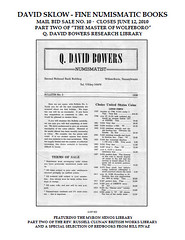 NUMISMATIC LITERATURE AUCTION SALE # 10 CLOSED JUNE 12TH
NUMISMATIC LITERATURE AUCTION SALE # 10 CLOSED JUNE 12TH
We would like to take this opportunity to extend a thank you to all our bidders and consignors; prices realized will be available as soon as possible; here are a few results [15% Buyers Fee NOT included]:
- Lot 114- The Mountain Men & Fur Trade of the West. $1500.
- Lot 165- ANA Centennial Auction Deluxe Bound. $165.
- Lot 275- Walter Breen's Letter to QDB. $330.
- Lot 356- Supplements to the Numismatic Circular [Ex: Ken Lowe] $357.
- Lot 357- Spink Numismatic Circular Scarce World War II Years. $413.
- Lot 527- The Asylum Vol. I-X. $370
- Lot 593- Stan Henkel Sale of the Dr. Maris Cabinet, Priced. [Cataloged by Smith] $619.
- Lot 617- St. Louis Stamp & Coin Auction April 13, 1906 [Plated]. $220.
- Lot 679- Dan E. Groux Sale, Boston 1855. [Ex: Ken Lowe] $451.
- Lot 741- Armand Champa's Planning Sheets for the Invasion of Louisville. $357.
- Lot 860- Kolbe Sale Deluxe Quarter Leather Ford Library Part One. $440.
- Lot 863- Kolbe Sale Deluxe Quarter Leather Ford Library Part Two. $675.
The Lot that obviously got by the catalog viewers: Lot 747- Cal Wilson's appraisal of the Champa Library. A keen bidder secured it at $77.
Our next Sale # 11 is scheduled for Saturday October 9th 2010 and looks to be our finest effort to date!
Consignments included: Part III of the Q. David Bowers Research Library [Civil War, Maritime, Collectibles of every type, Original Photographs & Memorabilia of Abe Kosoff]; The Myron Xenos Collection of Early Auction Catalogs 1855-1875 in Attinelli sequence [many plated]; Selections from the Library of Bill Weber, many heavily annotated; A Special Selection of lots from the Bourne Family; Some treasures from Part IV of a New England Estate Library; and much more!
Send inquiries to: David Sklow-Fine Numismatic Books, P. O. Box 6321, Colorado Springs, CO 80934. Telephone: (719)-302-5686; Fax: (719)-302-4933; Email: numismaticbooks@aol.com. The catalog is currently accessible on-line: www.finenumismaticbooks.com Bids will be accepted by, telephone, fax, email and regular mail.
LAKE BOOKS 103RD SALE CLOSES JULY 13, 2010
Lake Books announces that the catalog for its 103rd mail-bid sale of numismatic literature is now available for viewing at http://www.lakebooks.com/current.html
The 503-lot sale features duplicates from the library of William A. Burd and encompasses all areas of the numismatic experience. The sale closes on Tuesday, July 13, 2010 at 5:00 PM (EDT) and bids may be placed via email, telephone, fax or standard mail. Please remember that the earliest bid received wins tie bids, so bid early !
Lake Books
6822 22nd Ave. N.
St. Petersburg, FL 33710
727-343-8055 Fax 727-345-3750
NEW BOOK: AUCTION PRICES REALIZED FOR PCGS-GRADED GERMAN COINS
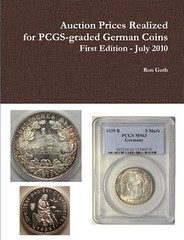 Your readers might be interested in my recent experience with on-line publishing through Lulu.com.
Your readers might be interested in my recent experience with on-line publishing through Lulu.com.
Over the last six months, I've been compiling auction prices realized for PCGS-graded German coins, an albeit narrow field, but one which interests me greatly as a collector and a dealer. By last weekend (June 6), I had compiled nearly 2,000 listings and had wanted to put it into book form to offer to other interested parties. Knowing this would be a limited-interest publication, I decided to try out one of the on-line publishers. My brother, who has had experience with publishing on-line, recommended Lulu.com
Lulu.com's website is very straightforward and intuitive. Essentially, you start a project, make some decisions as to the format and binding, use one of their ready-made templates to "build" your book, design a cover, order a proof copy, click a couple of buttons, enter payment information, and you're done.
I started the project Monday night (June 7). Most of my time was spent trying to move data from an Excel file to a Word file, then breaking it up into the various sections I needed. The front of the book included pages for copyright, Acknowledgements, Foreword, an explanation of why the book was important, About the Author, etc., so I had to write all of those, as well. In the end, the whole "innards" of the book came out to 60 pages.
I uploaded the file to Lulu.com and they confirmed that it was formatted properly. The next step was to design the cover. Lulu provides templates with great designs where you type in the title, add some images, build a promotional blurb, etc. If you want an ISBN number (optional but recommended if you want to be "seen" in the marketplaces for books), Lulu provides one and automatically drops it into the cover. Once you're done with the cover, you're done with the project.
I started the project at 8 p.m. and pulled the final trigger at 1 a.m., ordering 20 books. My cost was $133.72 which included shipping. Lulu estimated 10 days for processing, printing, and delivery.
Lo and behold, 108 hours (4.5 days) later, twenty pristine books showed up at my Post Office. I could not believe how smoothly, quickly, and easily this project went. And, the quality of the books is exceptional: glossy, color cover, perfect binding, 8.5" x 11" format, crisp printing on quality paper.
If I don't spend another dime, I can simply sell or give away my 20 books all by myself, but Lulu.com will continue to offer them as a print-on-demand book at my retail price of $49.95, giving me the bulk of that amount as my "royalty." For $175, Lulu will offer the book to the international market, meaning that it will be available on Amazon.com or through Barnes and Noble (and/or any bookseller that uses the ISBN database).
This is my tenth book as an author or co-author, so I've had some experience with various editors and publishers. For a first-time attempt at on-line publishing, I could not be happier and I'm as proud of this book as any other I've written. I plan on publishing updated versions of the book every six months because...guess what...I can do it easily and inexpensively through Lulu.com.
If anyone would like to obtain a copy of this first effort, visit Lulu.com and search their bookstore for "Auction Prices Realized for PCGS-graded German Coins" by Ron Guth. You'll get a great book AND a vision of what you, too, can do.
To read the complete article, see: Auction Prices Realized for PCGS-graded German Coins (www.lulu.com)
NEW BOOK: SILVER COINAGE OF EARLY MEDIEVAL INDIA
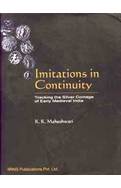 Imitations in Continuity: Tracking the Silver Coinage of Early Medieval India
Imitations in Continuity: Tracking the Silver Coinage of Early Medieval India
Author(s) : K.K. Maheshwari
Format : Hardcover
ISBN-13 : 9788186786284
Pages : 320p., 153 Figures; Bibliography; Index
Pub. Date : 01 Jan 2010 , 1st ed.
Publisher : IIRNS Publications
Language(s) : English
Contents: Introduction: Mapping the journey of Indo-Sasanian coinage.
1. In search of beginnings: i. The Sasanian originators. ii. Enter the Huans. iii. Firuz's coins: replications and implications.
2. Enter: two great early medieval currencies: i. Currency in flux: from the mints of the Marauders. ii. Invaders Indianised: the spread of the Gurjara-Pratiharas. iii. Drammas and Gadhaiyas: sorting out variants.
3. Tracking the evolution of the Gadhaiya: i. More about the Gadhaiya branch of the Indo-Sasanian family. ii. Gadhaiya Type I. iii. Gadhaiya Type II. iv. Inscribed Gadhaiyas. v. Malwa Gadhaiyas.
4. The Dawn of Eastern Indo-Sasanian currency: the Chahamanas: i. The Vasudeva imitations. ii. Sri Ha coins. iii. Derivatives of Sri Ha.
5. Eastern Indo-Sasanian currency reaches its Zenith: the pratiharas: i. The Monetisation of the imperial Pratihara empire. ii. Sri Ma coins. iii. Vigrahapala Drammas. iv. Srimadadivaraha drammas. v. Vinayakpala drammas.
6. Contemporary references. Wrap up: Sifting the basket of Indo-Sasanian currencies.
For more information, see: Imitations in Continuity: Tracking the Silver Coinage of Early Medieval India (www.bagchee.com/en/books/view/59988)
BOOK REVIEW: NUMISMATIC FINDS OF THE AMERICAS BY JOHN KLEEBERG
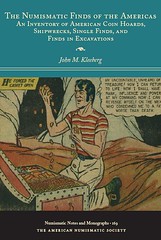 Kleeberg, John M., Numismatic Finds of the Americas – An Inventory of American Coin Hoards, Shipwrecks, Single Finds, and Finds in Excavations, Numismatic Notes and Monographs #169 under the Auspices of the International Numismatic Commission, American Numismatic Society, New York, 2009.
Kleeberg, John M., Numismatic Finds of the Americas – An Inventory of American Coin Hoards, Shipwrecks, Single Finds, and Finds in Excavations, Numismatic Notes and Monographs #169 under the Auspices of the International Numismatic Commission, American Numismatic Society, New York, 2009.
“He forced the casket open. An uncountable, unheard of treasure!...” from the front cover, taken from The Count of Monte Cristo, #3 Classics Illustrated.
John Kleeberg analyzes treasure hoards in text book depth from the Americas, not in pictures or in breathless narrative, but in list form. This is an advanced book for the specialist who knows about named shipwrecks and land hoards in the Americas, but is unable to recall exactly which coins were brought to light from the Economite Hoard, Rio de la Plata, or the HMS Feversham.
The list of finds in the Americas is astonishing for its breadth and span. John is meticulous, comprehensive and accurate starting with a silver penny of Olaf III Kyrre from Brooklin Maine. He proceeds through over 350 pages of well-known and lesser known hoards, shipwrecks, votive offerings, and cornerstone contents, reported in 18th century newspapers up to 21st century emails from finders across the Americas.
In each case, John attempts to specify what coin types, mints and dates open and close each hoard and offers detailed inventory of many that have gone to auction. John pulls coin facts from published accounts, newspapers, auction catalogs, and personal correspondence.
Part I details in nearly 250 pages, Numismatic Finds of the Americas. Part II accounts for U.S. Treasury Accumulations and Release of U.S. Silver Dollars, and Part III, a truly fascinating section, details Finds of American Coins Outside the Americas.
While E-Sylum readers might know about Viking pennies found in fishing villages in Maine, what is the first recorded coin of American origin documented in Europe? What is the first coin of North American origin found outside the Americas? What did they find at Fulbeck Hall, Lincolnshire in 2002? Advanced collectors own many of the coins listed and may better place their treasures in historical context after reading this book.
John includes full references befitting an academic work and spans original sources from the great 19th century numismatists to modern experts such as John J. Ford, Walter Breen and Q. David Bowers. Lastly John gives us an index of great value to historians defining coin types featured in which hoards. John's Kleeberg's book Numismatic Finds of the Americas is available at a discount to ANS members from the David Brown Book Company.
To read the earlier E-Sylum article, see: NEW BOOK: NUMISMATIC FINDS OF THE AMERICAS BY JOHN KLEEBERG (www.coinbooks.org/esylum_v12n11a02.html)
THE BOOK BAZARRE
ARTICLE SPOTLIGHTS RED BOOK COLLECTOR SCOTT WHITE
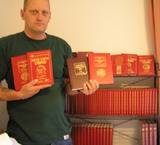 Scott's dream collection, and the one he has put the most time and energy into completing, isn't a coin collection at all, but a collection of books about coin collecting. To be precise, Scott's most elusive collecting endeavor was to compile a complete collection of the U.S. Coins "Red Books," properly titled A Guide Book of United States Coins by R.S. Yeoman, and edited in recent decades by Kenneth Bressett.
Scott's dream collection, and the one he has put the most time and energy into completing, isn't a coin collection at all, but a collection of books about coin collecting. To be precise, Scott's most elusive collecting endeavor was to compile a complete collection of the U.S. Coins "Red Books," properly titled A Guide Book of United States Coins by R.S. Yeoman, and edited in recent decades by Kenneth Bressett.
The Red Book has been called the "coin collector's bible" because it is the most widely used U.S. coins price guide in the world. The first edition of the Red Book was published in 1947 to great acclaim by the coin collecting community. The first press run of 9,000 copies quickly sold out, necessitating a second press run of 9,000 more. Copies of this first edition are listed in the Red Book itself for $1,200 to $1,500 each, but anybody who has tried to buy a nicely preserved copy will assure you you'll pay much more than that to obtain one.
The second edition of the Red Book, updated for 1948, had a press run of 22,000 copies, and although exact press run figures aren't available for most years following that, the Red Book steadily grew in popularity and sales. By 1965, an astounding 1.2 million copies of the Red Book were printed for the 18th annual edition!
There have been several special editions published over the years with press runs ranging from 500 to 1,500 copies. These special editions typically have the same content as the regular editions for that year, differing only in the covers they got. Most of the special Red Books were issued in conjunction with the American Numismatic Association (ANA) and available only to people who attended that years' annual ANA convention banquet. Even with these small press runs and very limited distribution, the special Red Book editions weren't overly difficult to find, if one was persistent. All except one, that is...
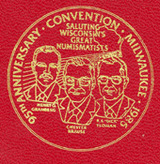 The highly sought after 1987 40th Anniversary Red Book with the Special ANA Cover has emerged as the rarest Red Book ever published. Although 500 copies were printed and distributed to the banquet attendees at the 1986 ANA convention in Milwaukee, Wisconsin, contemporary reports indicate that a large number of people simply left their copies behind, lying on the tables. There is no reason to doubt these accounts, because the 1987 Special ANA Red Book is very hard to find! In fact, Scott, (whom we met at the beginning of this article,) searched for many years to find a copy of this extremely rare and elusive edition to complete his collection of every Red Book ever published.
The highly sought after 1987 40th Anniversary Red Book with the Special ANA Cover has emerged as the rarest Red Book ever published. Although 500 copies were printed and distributed to the banquet attendees at the 1986 ANA convention in Milwaukee, Wisconsin, contemporary reports indicate that a large number of people simply left their copies behind, lying on the tables. There is no reason to doubt these accounts, because the 1987 Special ANA Red Book is very hard to find! In fact, Scott, (whom we met at the beginning of this article,) searched for many years to find a copy of this extremely rare and elusive edition to complete his collection of every Red Book ever published.
Now that Scott has completed his Red Book collection, he can't rest on his laurels, because several new editions of the Red Book have been coming out every year for the past few years. For 2007, there were eight different editions of the Red Book! These included variations such as hardcover, softcover, spiral binding, and leather covers; tribute editions to the original 1947 Red Book (in hardcover and limited edition leather covers;) and special editions for Michigan and for the ANA. With so many different versions of the Red Book coming out each year now, Scott might be spending more money on Red Books than he does on the coins they describe!
To read the complete article, see: A Complete Collection of U.S. Coins Red Books - U.S. Soldier Completes His Dream Collection (coins.about.com/od/uscoins/a/rareredbooks.htm)
MUSEUM CURATOR OPENING AT THE NATIONAL NUMISMATIC COLLECTION
The Smithsonian Institution has just posted a job opening for Museum Curator at the National Numismatic Collection. The chosen applicant will work for the Senior Curator, Richard Doty. Here are some excerpts from the job description. Yes, you can get PAID to immerse yourself in numismatics! The government hiring process is challenging, but well worth the effort for anyone who feels they've got the Right Stuff for the job. Good luck, applicants!

JOB SUMMARY:
This position is located in the Office of Curatorial Affairs, National Museum of American History, National Numismatic Collection, Division of Political History. The employee carries out the research, collections management, exhibitions development and education mission of the museum.
Duties:
- Researches American history primarily through objects and collections as well as traditional sources of documentation reflecting wider contexts of technology, culture and society.
- Collects and manages large and diverse collections
- Plans and develops exhibition concepts and content as a lead person in specialty area and as part of a team in broader subject areas.
HOW YOU WILL BE EVALUATED:
Your application will be evaluated first for the basic qualifications described above. The applications that meet the basic qualifications will be evaluated further against the following criteria:
- Skill in researching and writing on numismatics and American financial history as interpreted through material culture.
- Skill, as demonstrated through experience, interpreting, developing, and managing numismatic and financial history collections.
- Skill in developing exhibitions and /or other public displays, and related public programs.
To apply for the position, see: Job Title: Museum Curator (jobview.usajobs.gov/GetJob.aspx?JobID=88563865)
COINS-2010: SECOND EUROPEAN CONFERENCE ON COMMEMORATIVE COINS
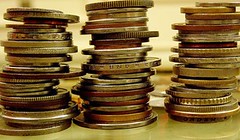 On June 9-10, the Second European conference on commemorative coins COINS-2010 will be held in St. Petersburg. Among the participants the mints of Russia, Great Britain, Canada, Austria, Hong Kong, Spain and other countries.
On June 9-10, the Second European conference on commemorative coins COINS-2010 will be held in St. Petersburg. Among the participants the mints of Russia, Great Britain, Canada, Austria, Hong Kong, Spain and other countries.
At the conference in St. Petersburg the experts will discuss the latest technologies in coinage, main trends in coin design, coins marketing and advertising, the current situation in numismatics and equipment for coins production.
"All over the world numismatists appreciate the original design and high quality of minting," Presnyakov says. "Last year we had a coin from Lichtenstein. It was a triangle coin of excellent quality. There are also coins with diamond inlaid work and some coins contain colorful inlays. For the production of such coins the latest technologies in coinage are used."
He continues: "In Russia the Central Bank is the issuer of commemorative coins. On the bank's website numismatist can learn what commemorative coins are to be issued during the year. In Russia the market of coins is regulated otherwise than in Europe. It is easy to bring coins from abroad but it is difficult to take them out of the country.
That is why, there are less numismatists in Russia than in Germany, for example. Our conference will give an opportunity to the numismatists to get familiar with the wide range of modern foreign coins and to buy some of them. At the same time foreign coin sellers will be able to learn about the preferences of Russian numismatists."
To read the complete article, see: St. Petersburg to host 2nd European conference COINS-2010 (english.ruvr.ru/2010/06/09/9436823.html)
SPMC AUTHOR'S FORUM AT MEMPHIS INTERNATIONAL PAPER MONEY SHOW
All bibliomaniacs and readers of books are invited to the 7th Annual Society of Paper Money Collectors Author's Forum. The event, which annually brings together book authors, publishers, hobbyists and wannabe authors, is unique in the numismatic hobby. Topics this year run the gamut of U.S. and international paper money topics.
This year's event will be held this Friday, June 18th, 2010, at the Memphis Marriott Downtown Hotel, Memphis, TN at noon-2 p.m. in Heritage Ballrooms 3 & 4 during the Memphis International Paper Money Show.
The forum includes book presentations by published authors of new works, and a chance for authors and readers to interact, purchase books and have them signed. "This forum was conceived as a way for authors and prospective authors of paper money books to exchange ideas, 'tricks of the trade,' and form mutual support on the long road between conception and publication of a worthwhile book," SPMC President Mark Anderson noted.
Authors this year include Dr. Fred Bart, author of United States Paper Money Errors, A Comprehensive Catalog & Price Guide (Krause, 2009); Cory Frampton, author of Mexican Paper Money (Mexican Coin Co., 2010); Morland Fischer, author of World Paper Money Errors (Zyrus Press, 2010); and a trio of authors who collaborated on Confederate Treasury Certificates: A Collector's Guide to IDRs (self-published, 2010), George Tremmel, Dr. John Martin Davis Jr., and Pierre Fricke. Emcee for the event is Wendell Wolka, author of several books himself.
The SPMC Author's Forum, in coordination with our Society's George W. Wait Memorial Prize which supports research of book length paper money projects, and its Wismer Publishing Program are parts of SPMC's outreach to hobbyists in support of numismatic education. Inquiries about the forum should be addressed to forum coordinator Fred Reed at fred@spmc.org. Information about SPMC may be obtained from Membership Director Frank Clark, P.O. Box 117060, Carrollton, TX 75011-7060.
SPMC thanks Lyn Knight, Memphis show proprietor, and Doug Davis, show chairman, of the Memphis International Paper Money Show for providing arrangements for the forum.
QUIZ ANSWER: HOW MANY DIFFERENT U.S. MINT BUILDINGS?
Last week Bob Neale posed the question, "How many different building facilities has the United States authorized to mint coinage?"
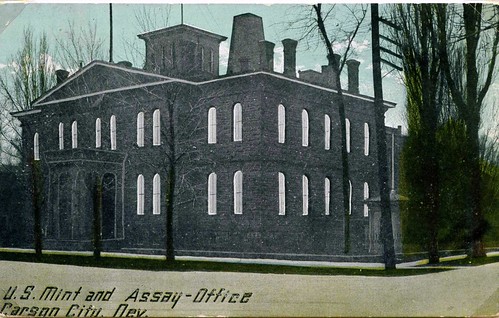
The Carson City Mint
Pete Smith writes:
I came up with a list of sixteen minting facilities. Two that might be missed are the ones at The Dalles, Oregon, or Manila, Philippines. However, I see problems with my list and realize I could write a long essay on the topic. Perhaps, if I can find the time, I will start that essay.
Then there is the problem counting Mint buildings. The first Philadelphia Mint had about a dozen buildings. I have less information about other facilities with multiple buildings.
The Coin World Almanac does not mention the Mint at The Dalles. I thought David Ganz' book on coinage laws would mention all the authorizing bills but that was a big disappointment.
A general observation: Bills in Congress authorize the establishment of a Mint. They are less likely to authorize construction of a building. That is part of the frustration. I was hoping for more information about the buildings.
One of the Mints I count is the third Denver Mint, authorized by Congress but never built.
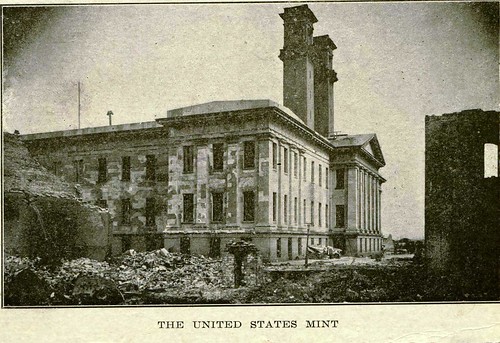
Second San Francisco Mint, after 1906 Earthquake and Fire
OK - here is Bob Neale's list of sixteen Mint buildings:
- Philadelphia (4)
- Charlotte (2, including rebuilding after consumed by fire 27 July 1844)
- Dahlonega (1)
- New Orleans (1)
- San Francisco (3)
- Denver (1)
- Carson City (1)
- West Point (1)
- Manila (1, Philippines Territory, 1920-1941, in an existing building; after coinage 1903-1919 at P and S mints)
- The Dulles (1, in Oregon, authorized in 1864 following discovery of gold in Rogue River Valley; building 1868-1870 was terminated with only basement and first floor completed; never struck coinage.
Mark Borckardt writes:
That was a great question, and it is subject to interpretation. Here is my answer, even though the actual buildings were not authorized by the U.S., in a couple cases.
1. First Philadelphia Mint
2. Second Philadelphia Mint
3. Third Philadelphia Mint
4. Fourth Philadelphia Mint
5. Denver Mint
6. First San Francisco Mint (beginning in 1854)
7. Second San Francisco Mint
8. Third San Francisco Mint
9. West Point Mint
10. Charlotte Mint
11. Dahlonega Mint
12. New Orleans Mint
13. Carson City Mint
14. The Dalles, Oregon
15. The Denver Mint of Clark, Gruber was intended to be operated as a United States Mint, although the government produced no actual coins at that facility.
16. The U.S. Assay Office in San Francisco, operated by Augustus Humbert absolutely qualifies
17. The “Fugio” Mint where the 1787 Fugio cents were produced.
I have attached illustrations of 16 of those 17 listed. The combination of "building facilities" and "authorized" pose the challenge. Does that mean "authorized to build," or "authorized to occupy?"
For example, the San Francisco Assay Office occupied by Augustus Humbert when the US Assay gold coins were produced may have been a previous structure that the government authorized Humbert to occupy, rather than a new building constructed for the purpose.
Also, we could add "Harper's cellar" to the list for the 1792 half dismes, if that is where they were struck. Then there are the Nova Constellatio patterns. Continental dollars (or whatever they are) could also be included.
If the Charlotte Mint burned down before coinage began (and I have never heard of that before) was rebuilt, was it also reauthorized? If not, then it doesn't count as two, only as one. The only southern mint that burned down, to the best of my knowledge, was Dahlonega, but that was long after coinage ended.
Click here to view all of Mark's U.S. Mint building illustrations on our Flickr archive (Many thanks to Mark and also to John Salyer for uploading these): www.flickr.com/photos/coinbooks/sets/72157624261506804/

The New Orleans Mint
Mark Borckardt adds:
I will be speaking at the Whitman Expo in Baltimore on Friday, June 18, at 2 PM. The title of my presentation is "60 Minutes at the First Mint" and my goal will be to tell the entire history of that facility in an hour. I am looking forward to seeing many The E-Sylum readers in Baltimore. Here is a link for more information: www.whitmanexpo.com .
To read the earlier E-Sylum article, see: QUIZ QUESTION: HOW MANY DIFFERENT U.S. MINT BUILDINGS? (www.coinbooks.org/esylum_v13n23a14.html)
MORE ON COIN STRIKING PRESSURE CALCULATIONS
Last week Dick Hanscom asked:
So here is my physics problem. I have built a "new and improved" (read heavier) drop hammer. I am curious how many pounds per square inch will be created upon impact on my die.
The weight is 50 Pounds.
The distance is 5 feet.
The surface area of the die is 1.25 square inches.
Using the Internet I am able to get it down to Kinetic Energy (337.84 J), but don't know if that can be converted into pounds per square inch.
Eric Holcomb writes:
Calculating impact pressure is a complicated physical problem that depends upon the properties and deformation of the object impacted, not just the simple laws of physics that were used to calculate the impact energy (338 joules). That's why you couldn't find a simple calculation on the Internet.
For the average impact force during the very brief process of stopping the hammer, you could write:
Impact Force x Impact (stopping) Distance = Impact Energy
If we assume a stopping distance of 1 millimeter (0.001 m) corresponding to the deformation of a typical coin, then in SI units:
Impact Force = 338 Newton-meters (joules) / 0.001 meters = 338 kN
Converting to English units and calculating the pressure for your specific case:
Pressure = 338 kN / (4.45 N/lbf) / 1.25 sq. in. = about 60 ksi (60,000 psi).
This is certainly in the correct range for the plastic deformation of metals at room temperature ("cold working"), but it could easily be off by a factor of 2 or more depending on the assumption about stopping distance and the details of what happens upon impact.
Dick Hanscom adds:
Five feet is not high enough for my drop hammer to strike my one ounce gold with a simple drop. Next test, I will “throw” it down and see if that makes a difference. Who knows, maybe the third test will be a hot strike.
To read the earlier E-Sylum article, see: TECH TALK: COIN STRIKING PRESSURE CALCULATIONS (www.coinbooks.org/esylum_v13n23a24.html)
MORE ON THE 1794 DOLLAR RATE OF RETURN
Regarding David Ganz' article on the 1794 Dollar and its return om investment, Bill Eckberg wrote:
This shows that since 1947, the rate of return on investment of this coin has been constant. The one sale where the price dropped slightly does not change that fact. This graph could easily be extrapolated to the future to predict when the coin will sell for $10M or even $100M or $1B, but I will leave such speculation
David Ganz writes:
Here are the details and formulas behind my graph. The rate of return formula is @Rate(end number, prior #,period of years). As you can see, it changes and varies. Here's what it shows from 1984-1991 and again from 1984 to 2010: as the average rate of return during t4he applicable period. The numbers matter and vary based on the formula. I did mine on Quattro Pro for Windows but it should also work on Excel.
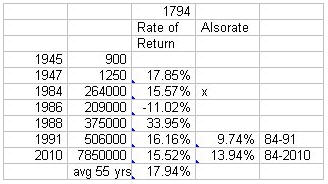
To read the earlier E-Sylum article, see: MORE ON THE 1794 DOLLARS (www.coinbooks.org/esylum_v13n23a17.html)
THE CLOSE RELATIONSHIP BETWEEN COINS AND BUTTONS (PART TWO)
Good Wife and I wanted to do something different last weekend. We chose to attend a button show. Whoa! What has that to do with numismatics? Plenty. Read on.
As we approached the registration table and learned the cost of admission I asked, perhaps out of habit, "Do you have a senior citizen discount?" The attendant smiled and said "This is a grandmother hobby, we charge extra for anyone under thirty." I smiled in return to her humor.
True enough as I glanced across the bourse area, dealer and collector were all over fifty. Wife and I qualified.
Buttons are displayed on cards housed in plastic tubs on dealer tables. I knew what I was seeking. "Where are your Scovill buttons?" I asked the first dealer as we approached her table. My goal was to view important buttons made by Scovill Manufacturing Company of Waterbury. At this show we were a dozen miles from the very spot where the Scovill factory had been located, now the Brass City Mall.
I thought someone from the area might be an expert on Scovill buttons I could meet and talk to. We pawed through the first tub dealer lady directed us to. Scovill buttons were few in that tub. But dealer lady's husband brought over another tub he went through. He found more than we did and we made a courtesy purchase of four Scovill buttons and moved on to another table.
Directed there to a tub of Military topical interest I pulled up a card with a dozen buttons attached. Button enthusiasts collect by topics much like token and medal collectors.
This card had descriptions written in a circular manor around the button. I read "Watchcase," on one, a term I had never encountered for buttons. "Pardon me, can I pick your brain? What does watchcase mean?" I asked the man behind the table who I had assumed was the husband-helper to this dealer lady. Boy was I wrong. I had encountered the expert I was seeking. Instead of being from the local area, he was from Tennessee!
Watchcase is a flat surface with beveled edge, he explained, much like watches of the day. After an exchange of several more questions and answers he came around from behind the table and sat next to me, leaving his wife to wait on other customers. We conversed for forty-five minutes. By sheer happenstance I had encountered the expert I was seeking.
I learned so much from him. He had been a professional geologist, an educator, and had left both fields to become a full-time button dealer. He knew Scovill very well, of course. And the other button manufacturers in the Waterbury area. Button collectors divide the field in two categories: Uniform buttons, and Dress-wear buttons. Scovill had produced uniform buttons for nearly 200 years, dominating the field.
Scovill had also produced tokens as well, virtually all the Hard Time tokens of the 1830s, and tons of Civil War tokens three decades later. It had also supplied the U.S. Mint with blanks. It made the planchets for the 1856-58 Flying Eagle cents when U.S. converted from large cents to small cents, and blanks for nickel coins. It struck coins for foreign governments a hundred years before Franklin Mint did. When the Philadelphia Mint learned it could not produce the tens of thousands of award medals for the Columbian Exposition it turned to Scovill to produce what it could not do -- a medal with an insert die to create raised lettering of the recipient's name.
Scovill was America's secret mint. It was the leading metalworker of New England, perhaps of all America for most of the 19th century. It struck its first token in 1829 and transportation tokens right up to World War II. And when it wasn't striking numismatic items it was making buttons.
There are three types of metal buttons: one-piece, two-piece, three-piece. One-piece has the fastener attached to the back. A two-piece has the front crimped around a back plate. A three-piece has a metal front, a back-plate and a band to hold the two together. Scovill had made all three, but was THE maker of two-piece buttons.
They had produced buttons for thousands of clients. Each required their own design. Each design required a unique die. I had examined hundreds of Scovill dies, for previous research, and had handled actual Scovill dies in a number of museums.
Then I asked my dealer-expert if he had any Mathew Boulton of Birmingham buttons. He did! He pulled out one that predated Boulton's establishment of the Soho Mint. And predated his own mechanism of button making and the Industrial Revolution.. It was larger than normal -- intended for a wealthy person -- and hand made. It had a dozen faceted bosses inset in a circle in a basin-shaped base. You could see the hand work file marks on the back.
As numismatic encyclopedias Ewald Junge once said: the best private coin and token makers were first button makers. This included Mathieu, Mercie & Mouterde in Lyon, Roche in Dublin, in addition, of course, to Boulton in Birmingham. The technology was similar for both fields, as was the equipment -- die making, rolling mills, blanking and striking presses. New technology also advanced along similar lines for both industries.
As I departed the show with a handful of new purchases I reiterated to Good Wife, there really is a close relationship between buttons and coins. A statement I had made previously in The E-Sylum (July 21, 2008, vol 11, no 29, art 13).
To read the earlier E-Sylum article, see: DICK JOHNSON: BUTTONS HAVE CLOSE RELATIONSHIP TO COINS (www.coinbooks.org/esylum_v11n29a13.html)
THE BOOK BAZARRE
ON THE DIANA GAMES OF CHANCE TWENTY DOLLAR GOLD PIECE
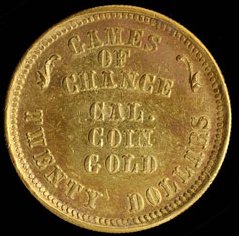

Harvey Stack writes:
The reason I described as I did, was that in usage and truth the private assayers in California, made coins as a MONETARY NECESSITY. So when you are running a wild and gigantic Gambling Operation, you needed things like "chips" to facilitate PLAY. So I guess it should be considered a MONETARY PROVISIONAL $20.00 GOLD.
David Gladfelter writes:
I'm not so sure that the “Diana” is a modern fantasy. How could it be? If it took Harvey Stack and his team of researchers so much effort to find a contemporaneous reference to this token, with a factual description that is a perfect match to the token, how would a fantasy artist acquire the knowledge to manufacture such a piece?
Of course that is the risk – that a faker will educate himself before making up a piece, so as to give it the appearance of being historical. But if the “Diana” is of the fabric, style and workmanship of the period, it is probably genuine, don't you think.
Duane Feisel forwarded me a lengthy discussion thread on the topic. Here are some highlights:
- The Hinton Helper book is actually a pretty common Gold Rush book.
- The Diana piece is called a fake in the online monograph "HOW THE WEST WAS FAKED" by John Kleeberg and T.V. Buttrey.
- While a lot of people have doubts about the Lilly "DIANA" piece, some are unconvinced by Kleeberg's reasoning.
Karl Moulton writes:
I enjoyed reading what Harvey Stack had to say about the value of books, and I completely agree with him. However, there were a few things that were not correct in his recollections regarding the $20 gold Diana coin.
As outlined in Helper's book, there was no house gambling, like there is today. There would have been no need for the Diana, or any other establishment to create any gaming coins (or "chips" as Mr. Stack and Mr. Ford wish to call them). I believe there are no other such pieces known, especially in gold, from the hundreds, if not thousands of gambling halls that were operating throughout California during the 1850's.
According to my copy of Helper's "The Land of Gold, Reality Versus Fiction" book, pgs. 70-74, the gambling floor was comprised of nothing but rented tables with different "proprietors" at each one; and each table had it's own "bank" that the "proprietors" of the tables controlled. "The bank", according to Helper, p.72, "is composed of gold and silver coin; it must be one or the other, or both of these metals in some shape - whether in dust, ingots, bullion, or coin; for these constitute the sole recognized currency of the State, there being no paper or bank-notes in circulation". Notice that Helper never described any "chips", "tokens", or house money.
In spite of what Mr. Stack suggests, Helper's book does not validate or "confirm" that the $20 gold Diana coin that exists today was struck in the 19th century or ever used at the Diana gaming establishment.
John Ford related that there were two such Diana pieces in Dave Bowers' 2002 book titled "A California Gold Rush History", footnote, p.350. If anyone knows the whereabouts of a second example, I for one would like to know where it is (or was, as it might have been melted), as I'm trying to finish up a few loose ends in my forthcoming book titled, "John Ford and the Franklin Hoard".
One other minor point of contention is the 1955 citation of the Diana having been sent to Stack's from an unnamed sender. According to an invoice in my possession, (acquired from the 2005 Ford Library part II sale, lot 1090) Ford traded the $80.40 Justh & Hunter gold bar and the $20 Diana gold coin to Stack's together on September 19, 1958. Confirmation of this can be read in the lot description. Stack's sold both of these, and many other previously unknown pieces that Ford and Stack's had authenticated, to Mr. Lilly for an undisclosed amount.
Both of those pieces have been suspect for a long time, with the $80.40 Justh & Hunter bar being declared a fake in 2003 by Evans, Holabird, and Fitch in their 3 part article that appeared in the Brasher Bulletin titled, "The Good, The Bad, and The Ugly". The "fatal flaw" was a round, noticeably double punched, Internal Revenue stamp (1864-1869) on a gold bar dated 1857. Additionally, the logo did not match the genuine Justh & Hunter gold bars that had been recovered from the S.S. Central America shipwreck.
The description of the Diana $20 gold coin in the NNC collection is most likely accurate, in that it is a mid-twentieth century "fantasy" coin and part of the "Franklin Hoard" material, like the $80.40 Justh & Hunter gold bar.
Yes, there is much value in books, as well as all other printed references, when doing research on American numismatics and other subjects.
To read the earlier E-Sylum article, see: HARVEY STACK ON THE VALUE OF BOOKS (www.coinbooks.org/esylum_v13n23a09.html)
WERE ANCIENT COINS WERE STRUCK HOT OR COLD?
Dan Demeo writes:
George Cuhaj et al. would do well to read about the experiments conducted in the early 1980's by Alvin A. Kleeb (1910-1994), editor at the time of SAN, the Journal of the Society for Ancient Numismatics. These were reported in SAN, Vol. XIII, No.3 and SAN, Vol.XV, No. 2.
Alvin found that ancient coins were struck while the blanks were hot, but the wedge-shaped splits found sometimes on the edges of ancient coins were caused by flans being struck while too hot. He also considers the practical matters of handling hot flans, freshly struck coins, and the dies while using a sledge hammer to strike his tetradrachm-sized "coins".
No, I don't know where one might obtain these issues, perhaps the American Numismatic Association Library. At one point, SAN had transferred their back issues to John Bergman, but I have no idea where they might have gone after his death. Dr. Lawrence Adams was the editor of the last issue of SAN I received, some 8 years ago
Tim Grat, Production Manager, Sunshine Mint, Inc. writes:
Where to begin on the Badger Mint Experiment...
First, I will leave it up to your more well-researched readers to cite the volumes of available material categorically describing the process of hot striking coins and the development into cold striking of blanks, which I can briefly describe as being parallel to the advancement of tool steel and the ability to harden to varying tempers. Which really brings me to some basic questions regarding the experiment.
I should probably say I do not disagree with the exercise at all. Many individuals will be duly educated by this and will get living information in real time, so kudos to the Badger Mint for providing the Summer Seminar with working tools in the craft! And supporting the project financially is something I hope those involved and interested in the project will fulfill. Now back to the questions...
What period of time is the project looking to recreate in terms of available tooling? Will the dies be made of bronze, and if so what alloy? If not, what type of iron/steel alloy will the dies be made of? Will the dies be hardened and/or tempered?
As you can see the question of hot vs. cold strike lies mainly in the preparation of the dies...with a few variables in the purity of material/alloy being struck.
I know all three individuals and certainly could ask these questions privately, but then the readers might lose the public exchange of ideas that we all enjoy!
Thanks again to Scott, George, and Joe for providing living history resources to the ANA and the collecting public and the E-Sylum forum for the exchange of ideas.
To read the earlier E-Sylum article, see: EXPERIMENT: WERE ANCIENT COINS WERE STRUCK HOT OR COLD? (www.coinbooks.org/esylum_v13n23a16.html)
NOTES FROM E-SYLUM READERS: JUNE 13, 2010
The most intruiging correspondence of the week comes from apparent web site visitor George Young who writes:
The William Strickland Columns referenced in your article are at George Young Company in Swedesboro, NJ.
Mr. Young left a phone number but we did not manage to connect this week. I'll follow up and report back when I can on the condition and plans for the old columns from the second Philadelphia Mint.
David Lisot of Cointelevision.com writes:
View lecture highlights from the recent Early American Coppers Convention. cointelevision.com.
Bill Rosenblum writes:
Lot #183 (poorly described) in my current auction closing Thursday is a comparatively recent restrike of the Mercator medal which was discussed in an issue or two of The E-Sylum last month. I have done further research and "know" the following about my specimen:
It is 69mm and weighs 78.84 grams and about 2mm thick. It has a tiny rim nick just to the right of the North Pole (on the Western Hemisphere side). The Hall Marks are four small rectangles ending with a script capital D. We believe that this is a London Hall Mark from 1978. See Discovering Hall Marks on English Silver by John Bly.
Unfortunately it probably isn't worth several million dollars so we will continue in business for the foreseeable future
Regarding the reference to Amon Carter's "International Paper Money Society ", Joe Boling writes:
Peter Symes has never heard of Amon Carter? The IBNS's twice annual exhibit award (conferred in Memphis and at the rotating meeting every fall in Australia) is named for Carter, who was charter member number 105 of the IBNS. Symes has won the award!
I'm sure that it is the IBNS that was being referred to as the International Paper Money Society. Incidentally, I knew that IPMS rang loud bells, but it was not until I pulled my organizational folder labeled "IPMS" that I remembered it is the International Primitive Money Society.
Dave Hirt writes:
We are leaving on the 15th for Budapest Too bad we'll miss the Baltimore show. The dollar is strong over there again, so I will hit the used book stores looking for numismatic books.
Web site visitor Mardi Harrison writes:
Can you tell me when the Library of Coins stopped making their coin books? I have a Lincoln Cents set that goes up to 1961, and wanted matching books to bring it current.
I asked our resident expert on coin albums, David Lange, who writes:
Library of Coins albums were printed through 1969 for most titles and through 1971 for Lincoln Cents.
Tom DeLorey writes:
Please tell Chick Ambrass that the Roger Miller song he is referring to is entitled "Dang Me!"
QUICK QUIZ: MYSTERY NUMISMATIST IN 1885
Jerry Fochtman writes:
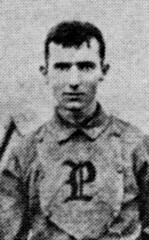 I've attached a picture of a young man who later in life wrote a couple of milestone books on numismatics. This photo shows him as a member of a local softball team that was called the Pioneers and I doubt few have seen this.
I've attached a picture of a young man who later in life wrote a couple of milestone books on numismatics. This photo shows him as a member of a local softball team that was called the Pioneers and I doubt few have seen this.
Next week I'll send a picture of this person later in life, which will probably surprise a lot of folks..... but chances are he still won't be well recognized, although his name is well known.
2010 BOSTON ANA MEDAL FEATURES PAUL REVERE
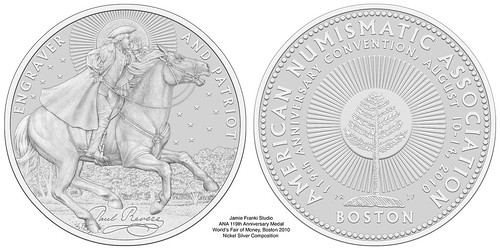
The official medal for the American Numismatic Association's 119th Anniversary Convention, August 10-14 in Boston, is available for purchase. Designed by Jamie Franki, former master designer in the United States Mint's Artistic Infusion Program, the medal celebrates one of Boston's most famous citizens, Paul Revere. The obverse depicts the engraver and patriot's storied “Midnight Ride,” while the reverse calls to mind designs he engraved for a 2-shilling issue of colonial currency.
Franki began the design process by consulting Patrick M. Leehey, research director of the Paul Revere House and Museum in Boston.
“He suggested excellent reading material and also gave me a good idea of what Revere wore on his ride,” said Franki. “I employed the assistance of a seamstress who specializes in historic garments. She created a period-authentic outfit based on the direction I received from the Revere House. A friend let me borrow a horse for a photo shoot. I spent an afternoon at her farm in Concord (N.C.) dressed in colonial garb and riding the horse.”
From the photos, Franki created composites, sketching in Revere's face based on portraits by various artists. He completed the design with a replica of Revere's signature, taken from his handwritten account of the ride to Concord.
The artist relied on Clarence S. Brigham's reference Paul Revere's Engravings for the reverse design, examining reproductions of the colonial currency engraved by Revere to adapt his “rising sun” and “pine tree” devices from a 2-shilling note. This design anchors the legend for the ANA 119th annual convention. Two sets of initials attribute the design of the medal to Paul Revere and Franki. A border of 119 beads and a rim completes the composition.
WAYNE'S NUMISMATIC DIARY: JUNE 13, 2010
Regarding my recent car accident, Charlie Davis writes:
Frightening scenerio. Thank God all is OK although I imagine you will have aching muscles for a while. I can't believe Tyler played a game after that!
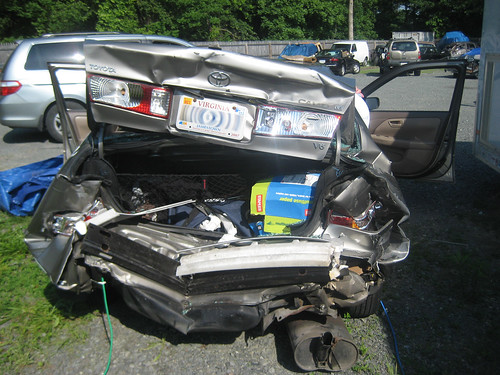
Dick Hanscom writes:
Tyler must be a true athlete, playing a game after such an accident! Does he play shortstop? Sorry, had to ask as I am a shortstop chauvinist. Thanks for all your work on The E-Sylum, especially under the circumstances this week.
Jim Duncan of New Zealand writes:
Buy yourself a lottery ticket! Or two. Time they made using a cell phone while driving illegal. They did so here a few months ago. Glad you are okay though - who on earth would take up the flame if you were out of action for any length of time? I drive a Toyota too, love 'em.
Denis Loring writes:
Scary. I'm glad you and Tyler are OK. Is the car a silver 2000 Toyota Camry? That's exactly what I have. Your story reinforced my faith in it.
That's right - my car was a 2000 Toyota Camry. I bought it December 31, 1999, ten and a half years ago.
Steve Shupe of Audi writes:
I am glad to hear that you are okay! Being in the automotive industry, from looking at the pictures that you sent, the vehicle crumpled as designed. Modern vehicles are designed to absorb energy from collisions by buckling and folding. This action absorbs the energy and protects the passengers. Yes, the vehicle may be destroyed, but the people live to see another day. (I am quite sure that the vehicle will be totaled)
Yep - it was a total loss. Roger Burdette writes:
Your accident photos certainly showed how good modern safety features are. In the 1980s you and your son would probably have been badly hurt and the other driver killed.
Bruce Perdue writes:
Glad to hear that you and your son survived the crash. Having been in a similar accident may years ago I can tell you that the whiplash may not show for months or years, but that I can point to that accident as the beginning of my back problems. I bent the seat back not quite as far as you did, but more than enough to know I had been hit hard! Be well!
My doctor warns all her patients against distracted driving, but none of them ever admits to having done it. It's almost funny - I'd just that afternoon read an article about new technologies that will let cars take over from humans when necessary to prevent accidents like this. Maybe Tyler will grow up to live in a less dangerous world.
Many thanks to everyone who wrote to me after reading about my car accident last week. Other well-wishers included Darryl Atchison of Ireland, Ken Berger, Dave Bowers, Gene Brandenburg, Dan Demeo, Larry Dziubek, Bill Eckberg, David Fanning, Chris Fuccione, Adrián González of Mexico, Nick Graver, Katie Jaeger, Tom Kays, Larry Koblenz, David Lange, Bob Leuver, Bob Metzger, Pete Mosiondz, Jr., Karl Moulton, Mike Paradis, Bill Rosenblum, Dave Schenkman, Tim Shuck, Jeff Starck, Michael J. Sullivan, Saul Teichman, George Vanca, Harry Waterson, and Tom Wetter.
I'm doing pretty well now, and have a brand new car parked out front, thanks to my insurance policy and a decent credit rating. Hopefully this one will die peacefully, of old age. Bid generously in Joe Levine's Baltimore auction - I consigned some nice medal lots to the sale!
And while I hate to make promises, the Gods of Family Time Scheduling have thus far smiled upon me. Lord willing and the creek don't rise, I hope to attend part of the Whitman Baltimore Coin Expo next Saturday, June 19th. I hope to see some of my readers there.
To read the earlier E-Sylum article, see: WAYNE'S WORDS: THE E-SYLUM JUNE 6, 2010 (www.coinbooks.org/esylum_v13n23a01.html)
THE BOOK BAZARRE
MORE ON THE BISHOP'S WOOD HOARD OF ROMAN COINS
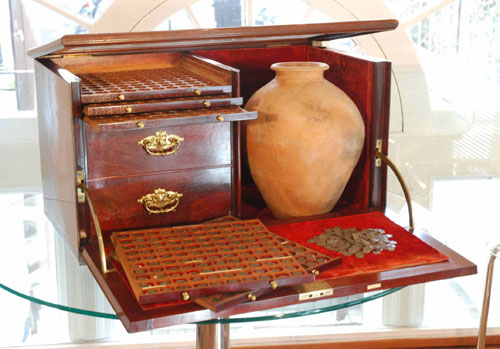
Sold as part of Baldwin's auction 64-65 on the 4th-5th May, the Bishop's Wood Hoard of Roman coins was amongst the lots in the Ancient section which opened the second day of the sale. The 1,661 coins and the restored jar that contained them were sold in 11 lots, including the purpose built cabinet in which they were housed.
The lots drew worldwide interest amongst the ancient numismatic community prior to the auction as the expertly cleaned and preserved coins had remained out of circulation and in the family of the landowner since their discovery in 1895.
Serious pre-sale interest came mainly (and encouragingly) from UK based dealers and collectors but also from some important UK institutions. Bidding was frenzied and busy, both in the room and on the book, but in the end the lots were all won by the same bidder. Baldwin's are very happy to report that this part of the hoard remains intact. In total the 11 lots (lots 1152-1162) achieved £46,964, well over pre-sale estimate.
Baldwin's Ancient expert Paul Hill commented after the auction ‘the sale of this hoard was an unprecedented success, it sold well beyond any of our expectations and the vendor is absolutely delighted with the result.'
The hoard was discovered at Bishop's Wood, near Ross-on-Wye, just across the Herefordshire border and within the surroundings of the Forest of Dean. It was uncovered in a rough walling built against the hillside by workmen who were in the process of repairing a road and who struck an earthenware vessel containing the coins. The accidental strike from a pick broke the jar and scattered its contents in various directions.
Included with the hoard is a reprint of the article from the Numismatic Chronicle of 1896 where 17,550 coins were
listed in total and a reprint of ‘Notes on a Great Hoard of Roman Coins found at Bishop's Wood in 1895' from the
“Transactions of the Bristol and Gloucestershire Archaeological Society”, vol. XIX, both written by Mary Bagnall-
Oakeley. The latter also includes the author's handwritten annotations and a list, dated March 1898, of the
museums and institutions that she was aware had received portions of the hoard. They are listed as follows:
Hereford City Museum
Gloucester City Museum
Bristol City Museum
Rolls Hall Monmouth
Ludlow Museum
Newcastle on Tyne Museum
Norwich Museum
Newport (Monmouthshire)
Clifton College Museum
Monmouth School Museum
Sydney Museum (New South Wales) (by special request)
Caerleon Museum
Whitchurch School Museum (W. Ross)
Although 17,550 coins were listed originally a number had already been lifted and dispersed around the region by the time the coins were rescued.
The original intention of the hoard and why it was deposited at the findspot is uncertain. It is possible that the area in question was occupied by Roman soldiers at the time and, given its size, it has been suggested that the hoard formed part of a military treasure, intended as payment for the legions. Whatever the original purpose of the coins, the hoard is a fascinating primary source of information for the mints employed in supplying Britain with coinage.
For more information about the hoard please contact Baldwin's Ancient specialist Paul Hill at paul@baldwin.co.uk.
To read the earlier E-Sylum article, see: THE BISHOP'S WOOD HOARD OF ROMAN COINS (www.coinbooks.org/esylum_v13n07a20.html)
DIGITIZING THE PAST AND PRESENT AT THE LIBRARY OF CONGRESS
The Library of Congress has nearly 150 million items in its collection, including at least 21 million books, 5 million maps, 12.5 million photos and 100,000 posters. The largest library in the world, it pioneers both preservation of the oldest artifacts and digitization of the most recent--so that all of it remains available to future generations.
I recently took a tour of two LoC departments that exemplify this mission: the Preservation Research and Testing Division in Washington, D.C., and the National Audio-Visual Conservation Center in Culpeper, Va.
The library's preservation specialists use the latest technology to study and scan ancient books, maps and other historical artifacts.
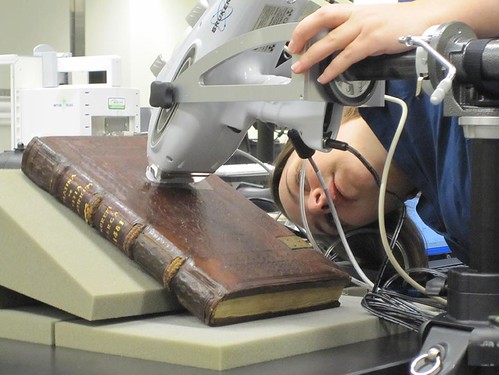
Fenella France, a research chemist with the Preservation Research and Testing Division, uses a 39 megapixel camera to take high-resolution images of documents ranging from renaissance-era maps to American state papers.
"We don't filter at the camera, we illuminate with small wavelengths," Fenella said. "We're creating a reference set of samples. We can't take samples of the documents themselves--it's just not going to happen"
This technique creates a set of images like a 'stack of cards,' all identically framed but revealing a different spectral face of the subject.
The Gettysburg Address exists on her computer as 8 different documents, each representing a different waveband in the visible spectrum. But only some show the mysterious fingerprint residue that may be Lincoln's own.
"In the next 5-10 years, I wouldn't be surprised if they could pull residual genetic information from the documents. [This is why] one of our foci is making sure that we don't interfere with future research."
To read the complete article, see: Gallery: Digitizing the past and present at the Library of Congress (www.boingboing.net/2010/06/09/gallery-digitizing-t.html)
NEW YORK TIMES: FURTHER THOUGHTS OF A NOVICE E-READER
I have been reading a lot on my iPad recently, and I have some complaints — not about the iPad but about the state of digital reading generally. Reading is a subtle thing, and its subtleties are artifacts of a venerable medium: words printed in ink on paper. Glass and pixels aren't the same.
When I read a physical book, I don't have to look anywhere else to find out how far I've gotten. The iPad e-reader, iBooks, tries to create the illusion of a physical book. The pages seem to turn, and I can see the edges of those that remain. But it's fake. There are always exactly six unturned pages, no matter where I am in the book.
Now, a larger problem. Books in their digital format look vastly less “finished,” less genuine. And we can vary their font and type size, making them resemble all the more our own word-processed manuscripts. Your poems — no matter how wretched or wonderful they are — will never look as good as Robert Hass's poems in the print edition of “The Apple Trees at Olema.” But your poems can look almost exactly as ugly — as e-book-like — as the Kindle version of that collection.
All the e-books I've read have been ugly — books by Chang-rae Lee, Alvin Kernan, Stieg Larsson — though the texts have been wonderful. But I didn't grow up reading texts. I grew up reading books. The difference is important.
When it comes to digital editions, the assumption seems to be that all books are created equal. Nothing could be further from the truth. In the mass migration from print to digital, we're seeing a profusion of digital books — many of them out of copyright — that look new and even “HD,” but which may well have been supplanted by more accurate editions and better translations. We need a digital readers' guide — a place readers can find out whether the book they're about to download is the best available edition.
And finally, two related problems. I already have a personal library. But most of the books I've ever read have come from lending libraries. Barnes & Noble has released an e-reader that allows short-term borrowing of some books. The entire impulse behind Amazon's Kindle and Apple's iBooks assumes that you cannot read a book unless you own it first — and only you can read it unless you want to pass on your device.
That goes against the social value of reading, the collective knowledge and collaborative discourse that comes from access to shared libraries. That is not a good thing for readers, authors, publishers or our culture.
To read the complete article, see: Further Thoughts of a Novice E-Reader (www.nytimes.com/2010/05/30/opinion/30sun4.html?emc=eta1)
AN INTERVIEW WITH DAVID LANGE
In this interview, David Lange—coin collector, author, and director of research for Numismatic Guaranty Corporation (NGC)—talks about the history of the Buffalo nickel, including its use as a canvas for creating caricatures in the folk art form known as hobo nickels. He also discusses Lincoln head cents and coin-collecting boards. Lange can be contacted via his website, coincollectingboards.net.
I started collecting coins when I was about 7 years old. I took over my brother's collection of Lincoln cents. At that time, the early 1960s, it seemed like every boy collected coins for a week or two and then got bored just like my brother did. I kept at it, collecting a little bit of everything over the years—from ancients to metals to tokens to paper money. I learn as much as I can, but usually my interest in a particular area runs out before I finish the collection. Very often I sell things to start something new.
David Feigenbaum, who put out the “The Complete Guide to…” series on U.S. coins, asked me to write about Buffalo nickels and Lincoln cents. He wrote the original books himself. He's since passed away. He did ones on the three Barber silver coin series and then wanted to expand the line into other popular series. I was asked to write about Buffalo nickels since I was already fairly well known in that field. That book went so well that I wrote one on Mercury dimes a year later. A couple years after that, I wrote the “The Complete Guide to Lincoln Cents.”
I also collect and sell coin boards and have a website devoted to them. The object of the coin board was to hold a complete date and mint series of a particular coin type. Most of the titles were for coins that could still be obtained in circulation at the time the boards were made in the 1930s. Very few boards were made for coins that were no longer circulating, and the ones they did make were generally poor sellers. Of course, those are the most rare today for collectors.
The business of selling them was somewhat of an unplanned offshoot of the publication of my book, “Coin Collecting Boards of the 1930s and 1940s: A Complete History, Catalogue and Value Guide.” For about 25 years, I bought every coin board I could find. The coin-board business was primarily a way to move the 400 to 500 duplicates I'd acquired.
To read the complete article, see:
An Interview With Author David Lange on Lincoln Cents, Buffalo Nickels and Coin Boards
(www.collectorsweekly.com/articles/an-interview-with
-author-david-lange-on-lincoln-cents-buffalo-nickels-and-coin-boards/)
AN INTERVIEW WITH U.S. MINT DIRECTOR EDMUND MOY
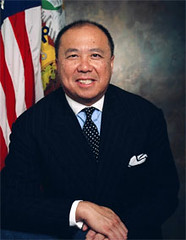 Michael Alexander: It's a real pleasure speaking with you today. The United States Mint is one of the most respected Mint institutions in the world. Can you tell readers how it feels to head such a well known and recognized entity?
Michael Alexander: It's a real pleasure speaking with you today. The United States Mint is one of the most respected Mint institutions in the world. Can you tell readers how it feels to head such a well known and recognized entity?
Edmund Moy: That's a very good question. Three things pop into my head. First, it's an honor to serve. There have been 38 Mint directors including myself since 1792, and I frequently tease the Secretary of the Treasury over this. There have been more than 70 secretaries in his post over the same period and only 38 Mint Directors! Second, what keeps me up at night is it's a great responsibility. You don't want anything bad to happen on your watch while trying to inject new life and design into numismatic products. Third, with the bullion market, we've now become the world's largest bullion producers, and we've also had to manage this growth. But overall, it's an honor and a big responsibility, and also fun!
MA: Now, about the smallest value coin. Will the one cent coin be dropped from circulation in the U.S.? We hear it costs much more to produce than its actual face value. EM: If you asked me about this six months ago, I would have said we were breaking even on the production of the penny. Now, it costs us roughly 1.6 cents to produce, and it might cost us a lot more in the future. When you look back to find legislation to discontinue the half penny or the two or three-cent coin, there were hardly any laws passed which specifically discontinued these coins. They were simply discontinued by the Mint because they were no longer in demand.
There are two ways to “get rid” of coins. One is by low usage and the other is by a law being passed. Since we just celebrated the two hundredth anniversary of the birth of Lincoln with our commemorative one-cent coins, I don't think the penny will be leaving us anytime soon. There is a lot of emotional attachment to this coin.
To read the complete article, see: Interview with Edmund Moy, Director of the United States Mint (news.coinupdate.com/interview-with-edmund-moy-director-of-the-united-states-mint-0318/)
BULGARIAN ARCHAEOLOGISTS DISCOVER SEVEN 13TH-CENTURY GOLD COINS
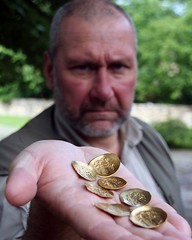 A team of Bulgarian archaeologists discovered seven 13th-century gold coins in the northern city of Veliko Tarnovo.
A team of Bulgarian archaeologists discovered seven 13th-century gold coins in the northern city of Veliko Tarnovo.
Archaeology professors Nikolay Ovcharov and Hitko Vachev found the treasure while excavating the St. Petar and St. Paul Church in the medieval Bulgarian capital, on the Tsaravets Hill, which hosted the Bulgarian royal palaces back in the 1200s-1300s.
The coins were discovered about 10 m away from the church at a depth of 40 cm in the ground.
This is the largest golden treasure ever found in Veliko Tarnovo, which was the capital of the Second Bulgarian Empire (1185-1396).
Each of the coins features an image of Virgin Mary on one side, and an image of Jesus Christ on the other.
Even though they are dated back to the rule of Bulgarian Tsar Ivan Asen II (1218-1241) who was the first Bulgarian ruler to mint gold coins, the coins in question did not originate in Bulgaria.
They came from the mint of John III Doukas Vatatzes, who was the Emperor of Nicaea in (1221-1254). The Empire of Nicaea was one of the successor states of the Byzantine Empire after Constantinople was conquered by the participants in the 4th Crusade in 1204 AD, which ultimately succeeded in restoring it in 1261.
To read the complete article, see: Bulgarian Archaeologists 'Strike' Gold Treasure (www.novinite.com/view_news.php?id=116932)
OLD JOKE: THE COUNTERFEITER
A big-city counterfeiter decided the best place to pass off his phony $18 bills would be in some small "hick town." So, he got into his very expensive new luxury car and off he went.
After driving for a while, he found a tiny town with a single store. He entered the store and handed one of the bogus bills to the man behind the counter. "Can you change this for me, please?" he asked.
The store clerk looked at the $18 bill for a short time, then smiled and said to the man, "Ah reckon so, mister. Ya want two nines or three sixes?"
To read the complete article, see: The Counterfeiter (www.gcfl.net/archive.php?funny=5316)
FEATURED WEB SITE: FRANKY'S SCRIPOPHILY BLOGSPOT
This week's Featured Web Site is Franky Leeuwerck's Scripophily BlogSpot. The blog covers interesting topics in the field of international stock certificates. Franky writes: "I'm collecting for more than 20 years and I am a member of the International Bond & Shares Society and the Norsk Selskap for Scripofili."
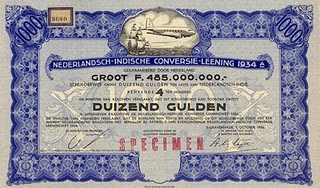
leeuwerck.blogspot.com/
